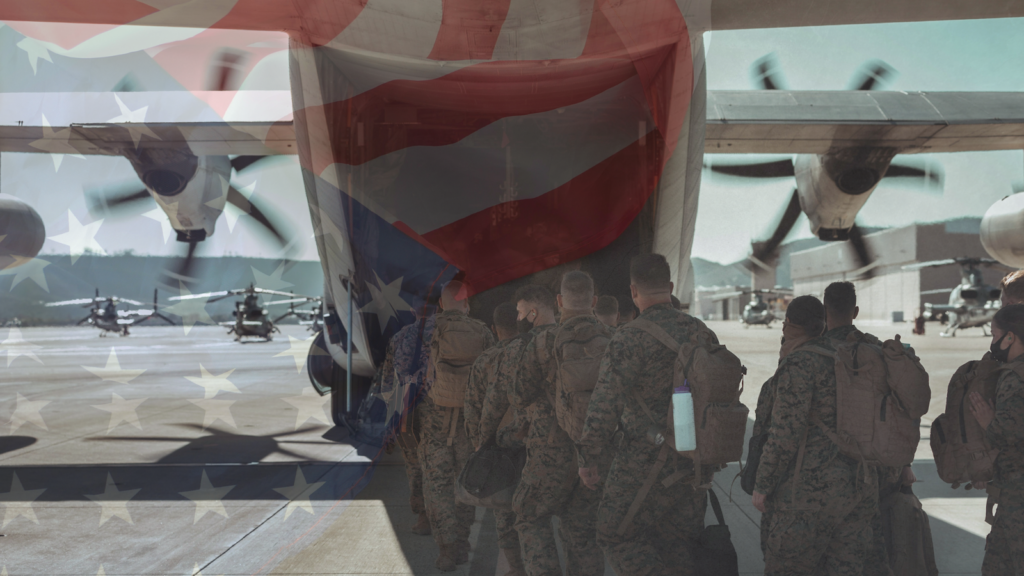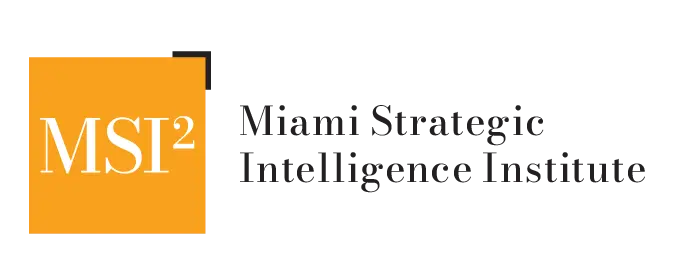28 Apr Unifying U.S. Military Power: The Case for an Americas Command
By,
Jesús Daniel Romero, Co-Founder and Senior Fellow, MSI² & PK Kelley, SME
China’s expanding economic and military footprint in Latin America and the Caribbean—coupled with increasingly agile asymmetric threats and escalating humanitarian crises—demands a strategic overhaul of U.S. military posture in the Western Hemisphere (Ellis, 2023). Currently, the United States splits the region between two combatant commands: U.S. Northern Command (NORTHCOM), which oversees the U.S., Canada, Mexico, and parts of the Caribbean; and U.S. Southern Command (SOUTHCOM), responsible for Central and South America and much of the Caribbean. But our adversaries are not constrained by these boundaries and neither should we be.
The time has come to unify these two commands into a single Americas Command, with Canada and Mexico as integrated partners. Led by a one-star U.S. flag officer, this restructured command would co-align Joint Interagency Task Force South (JIATF-S) and U.S. Naval Forces Southern Command (USNAVSO) at the same rank, reduce bureaucratic friction, and deliver faster, smarter responses to the region’s defining challenges—from great power competition to transnational criminal networks and natural disasters.
A Fractured Command in an Asymmetric Threat Environment
The Western Hemisphere is increasingly shaped by asymmetric threats—nontraditional, decentralized challenges that operate across physical and legal boundaries. Drug trafficking cartels and human smuggling networks have evolved into transnational enterprises that move more like insurgencies than criminal syndicates. They leverage stealth, corruption, encrypted communications, and maritime innovation—such as narco-submarines—to operate under the radar of traditional military constructs.
These networks actively exploit seams in the U.S. command structure. NORTHCOM and SOUTHCOM each have jurisdiction over parts of their operating theater, but their fragmentation allows trafficking pipelines to slip through the cracks. At the same time, the region faces a surge in climate-related disasters such as hurricanes, droughts, and flooding requiring rapid, coordinated military response. Divided commands mean delayed responses.
As these threats grow more adaptive, our structure remains static.
Strategic Gains Against Asymmetric Networks
A unified Americas Command would bring coherence to operations against these threats. Narcotics and human trafficking networks, like insurgencies, thrive on ambiguity and asymmetry—operating where the rule of law is weakest and military coordination thinnest. They cross rivers, borders, and sea lanes that U.S. combatant commands treat as operational barriers.
Consolidation would erase those seams, allowing faster deployment of intelligence, logistics, and interagency assets to disrupt trafficking corridors. It would empower military planners to treat asymmetric networks holistically, from the source zones of South America to the transit corridors of Mexico and the Caribbean and the demand centers of the United States.
JIATF-S—already a highly functional model of cross-COCOM and interagency integration—should be brought into structural parity with USNAVSO, both operating under a one-star headquarters. That parity would enable joint task forces and partner nations to operate more seamlessly across domains, including air, maritime, and cyber, against asymmetric actors who do the same.

Interagency Integration in Americas Command
Interagency integration will be pivotal to the success of a unified Americas Command (AMERICOM), particularly in addressing the increasingly complex and asymmetric threats in the region. Interagency coordination ensures that military, diplomatic, law enforcement, and intelligence resources are effectively combined to create a comprehensive, adaptive, and rapid-response strategy. In the context of AMERICOM, interagency integration will enhance both operational effectiveness and strategic coherence across diverse challenges, from counter-narcotics to disaster relief and geopolitical competition with adversarial powers like China and Russia.
Countering Transnational Threats
A core benefit of integrating multiple agencies under a unified command structure is the ability to mount a coordinated, holistic approach to transnational criminal networks and other asymmetric threats. The fragmented approach currently employed by U.S. Northern Command (NORTHCOM) and U.S. Southern Command (SOUTHCOM) allows illicit activities, such as drug trafficking and human smuggling, to slip through operational seams. By creating a structure where agencies like the Drug Enforcement Administration (DEA), the U.S. Coast Guard, and the Federal Bureau of Investigation (FBI) work seamlessly with military units, intelligence agencies, and regional partners, AMERICOM can leverage a comprehensive toolbox of capabilities.
Interagency integration under AMERICOM would streamline the process of intelligence gathering and dissemination, enabling faster responses to shifting threats. For example, when the U.S. government receives intelligence regarding drug trafficking routes across Central America, the U.S. military’s SOUTHCOM might receive the operational tasking to interdict vessels. However, under a unified command, agencies like the DEA and the FBI would already be engaged, ensuring that intelligence operations and law enforcement coordination work hand in hand with military operations. This would ensure rapid identification of trafficking networks, coordinated arrests, and the dismantling of key criminal nodes, eliminating redundancies and increasing operational lethality.
Diplomatic and Law Enforcement Collaboration
Beyond law enforcement, interagency integration in AMERICOM would also involve strong diplomatic and humanitarian components. The U.S. Department of State, the U.S. Agency for International Development (USAID), and partner governments will play critical roles in supporting the military’s efforts. In addressing humanitarian crises—such as those triggered by hurricanes or mass migration—AMERICOM will rely on diplomatic channels to ensure that regional allies are fully onboard and that international assistance is efficiently coordinated. The Department of State can facilitate collaboration with regional partners, ensuring that military operations respect sovereignty while remaining focused on regional stability.
Furthermore, interagency teams would be essential to overseeing and executing human rights protection, especially when responding to the needs of displaced persons or conducting counter-insurgency operations in areas affected by transnational crime. Such coordination would be critical in building trust with local governments and populations, ensuring that U.S. actions align with international law and regional norms.
Intelligence and Cyber Integration
A major element of the interagency integration in AMERICOM will be intelligence-sharing, particularly in the realm of cyber operations. The integration of U.S. Cyber Command (CYBERCOM) with regional partners will allow for faster identification of cyber threats linked to asymmetric warfare, whether they are tied to criminal organizations or state actors seeking to destabilize the region.
For example, narco-traffickers have increasingly used encrypted communications and digital platforms to coordinate activities, making the integration of cyber capabilities within AMERICOM essential for maintaining operational superiority. By combining the military’s cyber capabilities with those of the Department of Homeland Security (DHS) and private sector cyber experts, AMERICOM would be able to deliver targeted, high-lethality responses to these networks’ digital infrastructures, further disrupting their operations.
Humanitarian and Disaster Relief Operations
Given the vulnerability of the Western Hemisphere to natural disasters—such as hurricanes, floods, and earthquakes—interagency cooperation will be essential in organizing and executing effective humanitarian assistance and disaster relief (HADR) operations. AMERICOM would integrate U.S. military assets with those of USAID, the Centers for Disease Control and Prevention (CDC), and regional governments to ensure a swift and coordinated response to disaster zones. Through interagency task forces, AMERICOM would ensure that humanitarian aid is delivered quickly while maintaining security in affected areas.
An integrated approach will streamline coordination with NGOs and international organizations, which will be crucial when responding to large-scale displacement events or public health emergencies in the aftermath of disasters.
Operational Efficiency and Trilateral Integration
From a force posture perspective, an Americas Command would eliminate redundancy and accelerate multinational coordination. Canadian and Mexican forces—already engaged via NORAD, USMCA, and bilateral security agreements—would benefit from unified command relationships and shared doctrine in disaster relief, maritime security, and counter-narcotics missions.
NORAD’s functions would remain intact, functioning as a subcomponent of the Americas Command to preserve homeland missile defense and air sovereignty responsibilities. This respects Canada’s current role while enhancing strategic integration with its southern neighbors.
Real-world benefits would be immediate: faster deployment of Canadian airlift to Caribbean disaster zones, streamlined intelligence fusion with Mexico for maritime drug interdiction, and more predictable coordination between NORTHCOM and SOUTHCOM’s existing infrastructure.
Administrative and Economic Benefits
Economically, a unified command would reduce overhead costs by consolidating headquarters functions and administrative structures. It would eliminate duplication across support staff, planning cells, and liaison teams. Strategically embedded liaison officers from Canada and Mexico would accelerate information-sharing, planning, and interagency execution.
The command would also speak with a single voice to regional organizations like the Organization of American States and be better positioned to engage partners such as Colombia, Brazil, and others facing similar asymmetric threats.
Risks and Realities
Critics will rightly raise concerns. Would a one-star commander have the authority to manage such a diverse mission set? Would NORTHCOM’s homeland security focus be diluted? Could Latin American nations view deeper U.S.-Mexico-Canada integration as hegemonic?
These are valid questions. But answers exist.
NORAD would remain a distinct subcomponent, preserving homeland defense missions. Concerns about U.S. dominance can be addressed by anchoring collaboration in transparent, rules-based frameworks like USMCA. And the role of a one-star commander can be augmented with robust deputy commanders, joint staff integration, and specialized subordinate task forces. In fact, smaller, flatter command structures may prove more responsive in fast-moving asymmetric environments.
A Way Forward
The Department of Defense should initiate a trilateral task force with Canada and Mexico to explore this reorganization. Pilot programs—focused on disaster response, maritime security, and counter-narcotics—should be launched under joint NORTHCOM – SOUTHCOM oversight to test interoperability and structure.
The model is already in place: JIATF-S. Now it’s time to scale it up.
Conclusion
As China, Russia, and transnational criminal networks expand their influence and activity in the Americas, the United States cannot afford to be divided by outdated command structures. A unified Americas Command, grounded in trilateral partnership and focused on agile responses to asymmetric threats, would offer clarity, efficiency, and strategic deterrence.
We can’t afford NOT to make this change. As Dynamic – Asymmetric threats continue to evolve at a rapid pace, we MUST be willing to adopt changes and be open to adaptability to increase the capabilities of the United States of America. These changes will allow for intelligence, Joint Task Forces and other strategic capabilities to close the gap on communication and sharing of critical information further thwarting our nations enemies asymmetric advances at, near, or within the homeland.
References
Ellis, R. E. (2023). China’s strategic engagement in Latin America: Implications for U.S. security. Journal of Strategic Studies, 46(3), 321–345. https://doi.org/10.1080/01402390.2023.1234567
González, M. A. (2022). Mexico’s military cooperation with the U.S.: Sovereignty and security in the 21st century. Latin American Policy Review, 34(1), 45–67. https://doi.org/10.1080/01000015.2022.1817746
U.S. Department of Defense. (2023). Combatant command structure and strategic priorities: 2023 annual report.
U.S. Department of State. (2024). U.S. security cooperation in the Americas: Partnerships for the 21st century. https://www.state.gov/reports/americas-security-2024
PK Kelley
Special Operations Veteran | Entrepreneur | Intelligence Professional | National & Homeland Security Consultant | Status Quoted Disruptor
